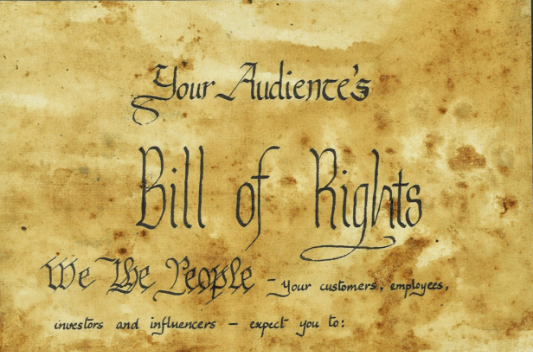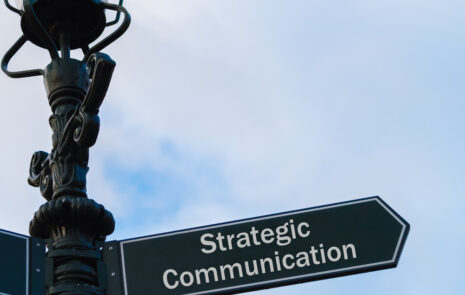
Your Audience’s Bill of Rights
The Audience’s Bill of Rights.
See marketing through your audience’s eyes
To help you see how marketing looks through the eyes of customers, I created the Audience’s Bill of Rights.
Most advice on marketing comes strictly from a marketer’s viewpoint. But we can learn a lot by looking at content through the audience’s eyes.
It’s crucial for marketers to know exactly what their audiences are looking for. Once you know what your customers want – based on your buyer personas, influencers, analytics, and direct experience – you can deliver what they expect.
Think of the Audience’s Bill of Rights as a way to ensure you always deliver marketing in a highly ethical way.
Seen through customers’ eyes, marketing messages are those things that interrupt them all too frequently. People get bombarded by 1,500 to 30,000 messages a day, says the Business Marketing Association.
Worse, many of these “marketing moments” violate one or more of the audience’s rights – what they rightfully expect from sellers and marketers.
Marketing that violates an audience’s rights may succeed in the short term. That’s been true ever since the days of patent medicines and continues to be true today with weight-loss pills and similar scams.
But in the long run, unethical marketing turns off audiences, hurts your brand’s prospects, and could create distrust about your entire category.
In a marketplace of distrust, it pays to be the marketer who always tells the truth, and treats your audiences very well. The more rarely ethical marketing occurs in your marketplace, the more valuable it becomes as a way to distinguish you from competitors.
When you understand and meet audiences’ spoken and unspoken expectations, your marketing is far likelier to succeed.
Our audiences deserve a Bill of Rights to spell out clear expectations for what they expect from marketers. Show audiences this kind of respect, and ultimately you and your audiences will both benefit from long-term relationships.
Think about the Audience’s Bill of Rights as a litmus test. Does your content marketing meet all of these audience needs before it goes public?
Your Audience’s Bill of Rights
We the People who hear your business message expect that you:
Article 1. Have a single, simple, understandable message.
Article 2. Know what you’re talking about.
Article 3. Say: What’s In It For Me? (WIIFM)
Article 4. Provide information I care about.
Article 5. Tell the truth.
Article 6. Respect my limited time and attention.
Article 7. Speak my language.
Article 8. Stay clear, concise, and consistent.
Article 9. Answer my questions.
Article 10. Do what you say.
Signed: Your Audience
Now let’s unpack the Audience’s Bill of Rights.

Article 1. Have a single, simple, understandable message.
As a successful financial advisor said, “The simpler I keep it, the more I sell.”
To get your message across, focus relentlessly on a single message, advises cognitive neuroscientist Dr. Carmen Simon. Trying to make multiple points rather than making one point well can lose your audience in a sea of confusion.
Keep your message simple and speak your audience’s language, avoiding industry jargon and acronyms they don’t know. Remember, confused customers, don’t write checks.
Above all, make your message understandable. As Albert Einstein said, “If you can’t explain it to a 6-year-old, you don’t understand it yourself.”

Article 2. Know what you’re talking about.
When you know your business, you can make it crystal-clear to your audience. But when you don’t, the content you create only puts ignorance on public display.
Never be afraid to say, “I don’t know, but I’ll find out and get back to you.” Never fake expertise you don’t have.
Stop posting content written by interns, hack freelancers, and people who never spent a day working in your industry. That kind of content quickly undercuts trust in your brand.
Article 3. Say: What’s In It For Me? (WIIFM)
To make your marketing pitch heard, make it crystal-clear.
Answer key questions: What’s the benefit for me (the customer)? How will you make my life easier? How will you help me advance my career? How will you make my business more profitable?
Don’t dance around this point: if your customer doesn’t see and feel the answer to WIIFM if she doesn’t get the benefit you’re offering immediately, then she’ll tune out. Game over.
Article 4. Provide information I care about.
Reach out to audiences. Spend enough time with them so you can walk a mile in their shoes and feel what they feel.
Care enough to do the homework: know who your audiences are, how they think, how your products fit into their lives, what their questions and worries are, and how your offerings solve their problems.
To do so, you need to spend a lot of time with customers face to face or conduct buyer persona research.
Article 5. Tell the truth.
Our elders were right when they taught us that “honesty is the best policy.” Make sure everything you say is true.
That doesn’t mean you need to tell everything! If there’s a “secret sauce” that gives you the advantage over competitors, like the formula for Coca-Cola, by all means, keep it a secret. But whatever you say about it, make sure it’s absolutely true.
Do the research to back up your assertions with proof. Avoid being like a politician who makes misleading or rapidly changing statements. Never overpromise.

Article 6. Respect my limited time and attention.
Believe it or not, your audience didn’t roll out of bed this morning hoping to see your marketing. If you want the audience to spend time with you, don’t waste their time with irrelevant details.
Tell them what they need to know, fast. Make sure it’s on point. Then shut up.
Article 7. Speak my language.
When your message offers your audience a benefit, they truly want to understand what you’re saying. So speak plain English. Avoid acronyms, jargon, and legal gibberish.
If your audience is doctors, speak to them in medical terms. If your audience is engineers, speak engineering to them. But avoid speaking engineering to the chief financial offer who speaks the language of finance … and vice versa.

When your audiences are in other countries, speak their local language, or – if that’s impractical – speak global English with a vocabulary of 1,500 words or less. Avoid idioms and analogies they don’t understand.
For example, don’t use cricket analogies in the United States or baseball analogies in Europe. People just won’t get what you mean.
Article 8. Be clear, concise, and consistent.
Be straightforward, direct, and to the point. Keep your message as short as possible.
Don’t change your story every time you talk to a customer. Consistency is the path to believability, neuroscience shows.
When you’re consistent you can earn a spot in your audience’s “place cells,” which, unlike other mechanisms of memory, never run out of capacity. Inconsistency consigns your message to short-term memory, where it’s much more likely to get lost.
Make sure your executives, marketing, and sales teams all know how to articulate your message well, with a 1-PageTM Message Map. Keep your language and message consistent across all business units, geographies, departments, and products.

Article 9. Answer my questions.
Knowing your audience means knowing what are their questions – all their questions.
When it’s time for your audience to make a buying decision, there’s no such thing as a “stupid question,” just the possibility of a stupid answer. When one customer is brave enough to ask a question, a hundred more customers may have the exact same question on their minds … but they hesitate to speak up.
That’s why you need to treat every customer question like gold.
Article 10. Do what you say.
Make sure your words and actions line up. Integrity is the key to winning business and securing customer testimonials. Make and keep your commitments.
Be clear about what you’ll do, and then do exactly what you said. When it’s time for your customer to recommend you or to buy again, you’ll be at the top of their list.
Make sure your marketing advances your company’s reputation with your audience.
Use this Audience’s Bill of Rights as a checklist. Before you ok your next marketing message, double-check to be sure you:
Have a single, simple, understandable message.
✔︎ Know what you’re talking about.
✔︎ Say: What’s In It For Me? (WIIFM)
✔︎ Provide information I care about.
✔︎ Tell the truth.
✔︎ Respect my limited time and attention.
✔︎ Speak my language.
✔︎ Stay clear, concise, and consistent.
✔︎ Answer my questions.
✔︎ Do what you say.
✔︎ Have a single, simple, understandable message.
Remember: What matters more than what you say is how you’re heard by your audience.
Treat them right! Stand out as an ethical marketer, someone customers can truly trust.
Your Audience’s Bill of Rights – Marketing Through Your Audience’s Eyes
Related Posts
Top 100 Content Marketing Question: “How do you escalate strategies and goals up to decision-makers?”
A marketer from Kaiser Permanente asked, “How do you best escalate strategies and goals up to decision-makers?” It’s among the Top 100 Questions on...
Top 100 Content Marketing Question: How to better align content to the buyer journey?
A smart marketer asked: “How can we better align content to the buyer journey, making it a personalized experience?” To align content to the...
When you see what to say, you say what you mean
See what to say and say what you mean with a Message Map. Developing a strategic message is a big job that every organization...
“How to increase your audience’s attention span with a Message Map”
“How can you move consumers along in the attention span journey from 7 seconds to 2 minutes, to 5 minutes?” asked a marketer from CarMax....





